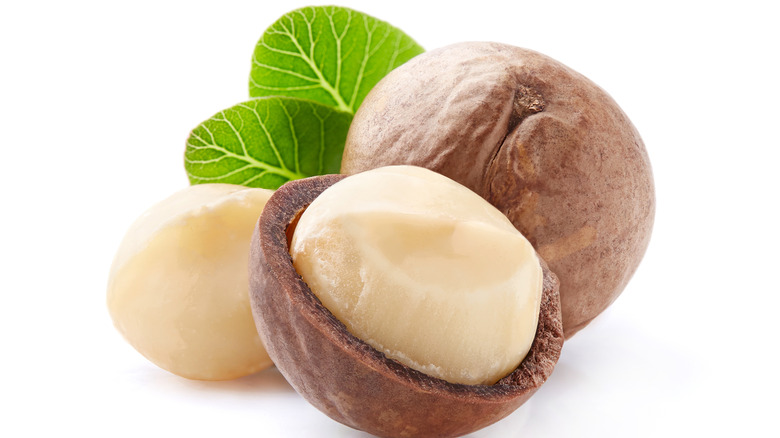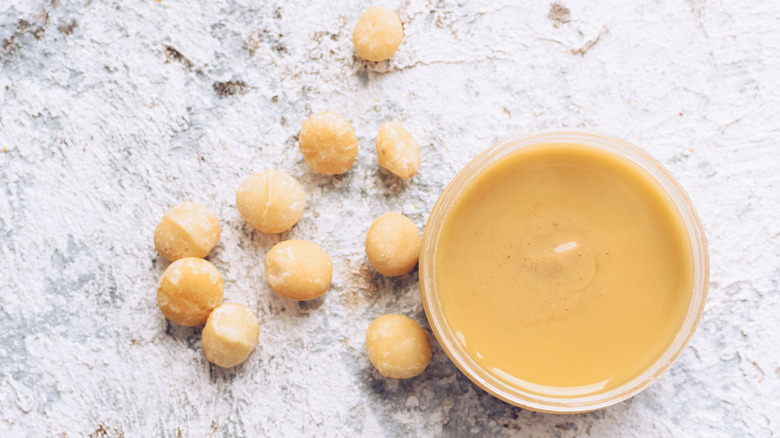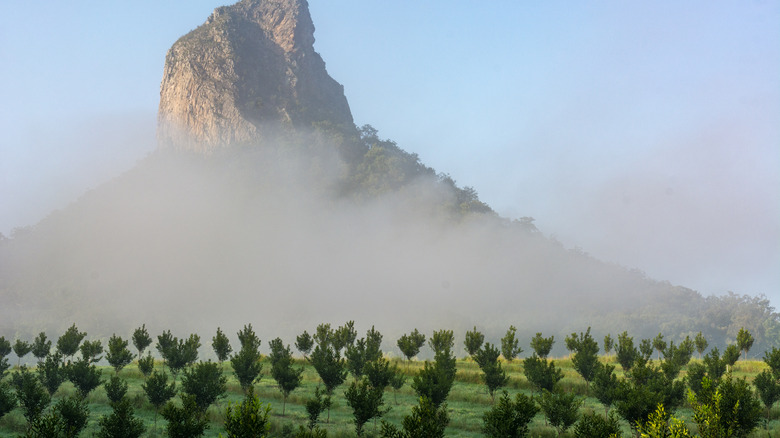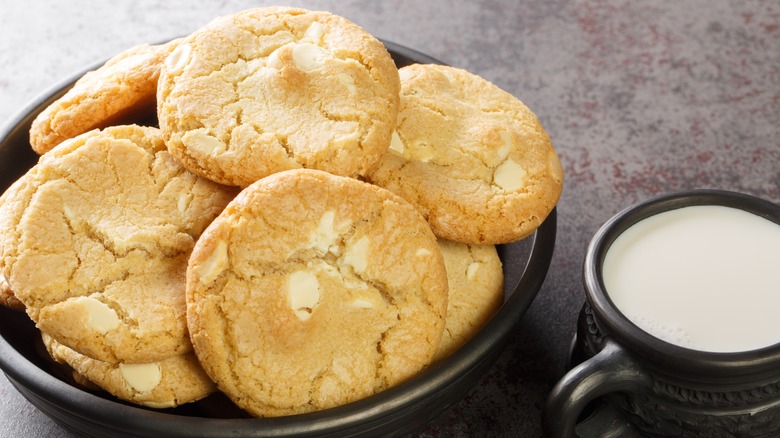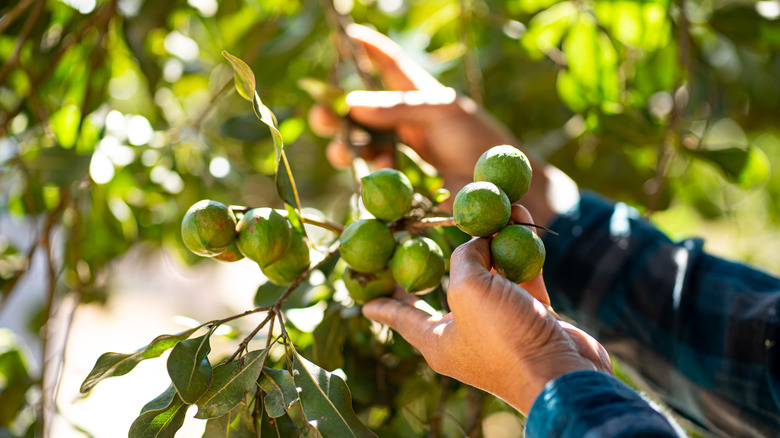Most Of The World's Macadamia Nuts Come From This Country
Out of all of the world's nuts, there is something especially enticing about macadamia nuts. Is it because they are associated with Hawaii and sweet recipes, such as Creamy Pineapple Pie and Island Breezes Coffee Cake? Or is it because they are not as commonly found on store shelves?
According to World Atlas, the macadamia nut ranks number eight on a list of the 10 most-eaten nuts in the world. The top three, perhaps unsurprisingly, are peanuts, almonds, and walnuts. The two nuts that are eaten less often than macadamia nuts, per World Atlas, are Brazil nuts and pine nuts. When comparing the number of macadamia nuts consumed to peanuts, the difference is astounding. More than 42 million metric tonnes of peanuts are eaten around the world annually, compared to only a little more than 50,000 tonnes of macadamia nuts.
As the reputation of nuts as a healthy food choice has grown, so has their consumption, according to Future Market Insights, which found that sales of edible nuts have increased by 5.5% from 2016 to 2020.
The health benefits of macadamia nuts
Macadamia nuts contain different minerals and vitamins, including manganese, thiamine, copper, magnesium, iron, and vitamin B6 (via Healthline). They are also fairly high in calories, with 28 grams of macadamia nuts containing 204 calories. In addition, that amount will have 23 grams of fat. The fat in macadamia nuts includes monounsaturated fats, which can help to lower total and LDL cholesterol levels, per Healthline.
Monounsaturated fat, according to WebMD, is good for a person's heart health and can help to reduce the risk of type 2 diabetes. Another reason to eat macadamia nuts is that they contain antioxidants and flavonoids, which WebMD advises combat inflammation. However, with their high caloric value, WebMD recommends eating macadamia nuts and others in moderation. Half of a cup of macadamia nuts contains about 475 calories. To eat macadamia nuts in a healthy way, WebMD recommends measuring out a portion of 10 to 12 nuts (about one ounce) in order to not overindulge during snack time or simply to incorporate a few on top of a salad instead of croutons or by adding them to trail mix.
Where macadamia nuts originate from
While no longer the leading producer of macadamia nuts, Australia is where they were first grown, according to Smithsonian Magazine. Macadamia trees still grow in the wild Down Under, but it is from those wild trees that much of the world's macadamia orchards originate. One place where macadamia nuts are grown is Hawaii, according to Smithsonian Magazine, and research has shown that all of Hawaii's trees might originate from one macadamia tree in Queensland, Australia. The trees' seeds were first brought to Honolulu in the late 19th century by two men.
It was along Australia's northeastern coast that macadamia nuts first grew, according to Australian Macadamias, and where many trees still grow today. For Australia's aboriginal people, macadamia nuts were seen as a treat to savor long before Europeans ever landed there. Beyond a food source, the nuts were traded between tribes and used as a ceremonial gift. The indigenous people of Australia had the nuts all to themselves until European botanists discovered them in the 1850s, chronicles Australian Macadamias. Once the secret got out about the buttery nuts, they were taken far beyond Australia's coasts.
The market for macadamia nuts
Macadamia nuts may have first grown in only one area of Australia, but now they are enjoyed by people around the world. In 2021, the exportation of the nut resulted in sales worth $592 million per World's Top Exports. 2021 was a good year for the nut after a few years of declining sales. World's Top Exports reports that worldwide demand increased by 10.7% compared to 2020, when sales amounted to $534.9 million. Of the macadamia nuts that were exported in 2021, the majority were fresh or dried nuts that had been shelled (67.7%), while the rest were fresh or dried in shell (32.3%), according to World's Top Exports.
The demand for macadamia nuts is anticipated to grow in coming years because of nuts' perception as a health food. The global market for macadamia nuts is anticipated to increase at a compound rate of 10.7% between 2021 to 2028, per Grand View Research.
The top grower of macadamia nuts
Perhaps not surprisingly, Australia was the top exporter of macadamia nuts for many years as the original growing location for the tree, but as it began to be cultivated elsewhere, other countries' production began to outpace the land Down Under. Australia remains in the top five countries that export macadamia nuts, per World's Top Exports, but has fallen to South Africa. Other leading exporters are Guatemala, Hong Kong, and Zimbabwe.
Centre for the Promotion of Imports reports that South Africa produces the most macadamia nuts, with about 57,000 tonnes of in-shell macadamia nuts and around 15,700 tonnes of macadamia nut kernels harvested annually. The top importers of South African macadamia kernels are the United States, Hong Kong/China, and Vietnam. Europe received about 30% of South Africa's macadamia kernel exports, with Germany being the destination for the most kernels, followed by the Netherlands, France, and Spain. While not a top grower of macadamia nuts, Hawaii is where commercial production of the crop started after machinery was invented in the 1940s for cracking the nut (via South Africa Online). The growing of macadamia trees is still a point of pride for the people of Hawaii, and tours are available of its farms, per Hawaii.com. Perhaps that's why so many macadamia nut recipes have a sweet, tropical flavor.
Whether you eat macadamia nuts for their health benefits or flavor (or both), they're always something to be enjoyed.
